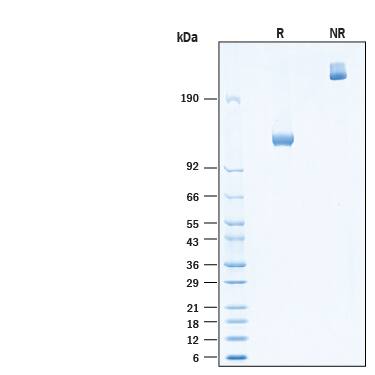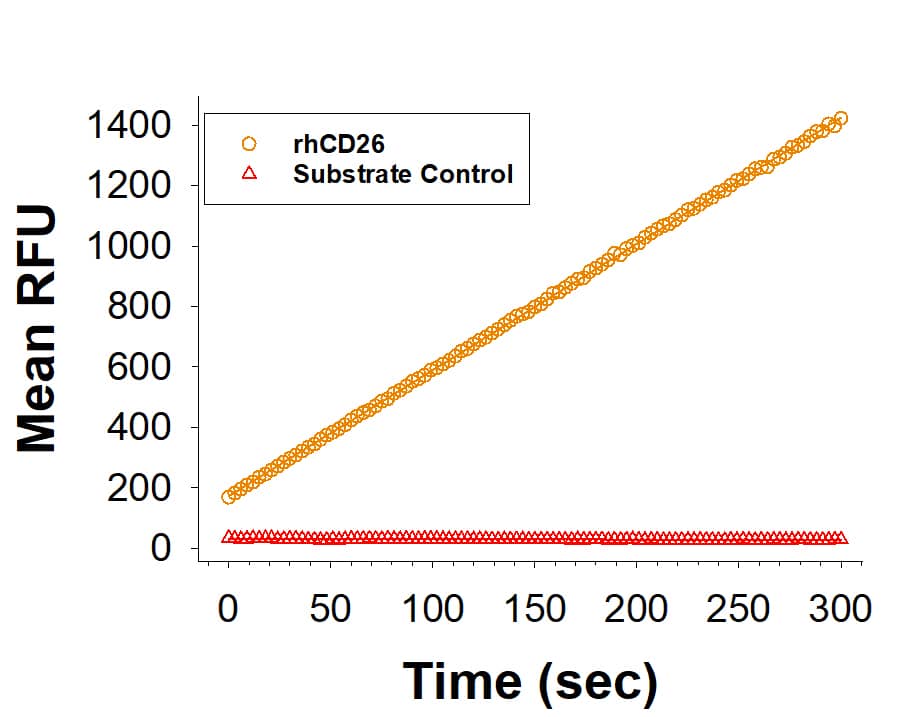Recombinant Human DPPIV/CD26 Fc Chimera Protein, CF
R&D Systems, part of Bio-Techne | Catalog # 11141-SE

Key Product Details
Source
HEK293
Conjugate
Unconjugated
Applications
Enzyme Activity
Product Specifications
Source
Human embryonic kidney cell, HEK293-derived human DPPIV/CD26 protein
| Human CD26 (Asn29-Pro766) Accession # CAA43118.1 |
DIEGRMD | Human IgG1 (Pro100-Lys330) |
| N-terminus | C-terminus |
Purity
>95%, by SDS-PAGE visualized with Silver Staining and quantitative densitometry by Coomassie® Blue Staining.
Endotoxin Level
<0.10 EU per 1 μg of the protein by the LAL method.
N-terminal Sequence Analysis
Asn29
Predicted Molecular Mass
112 kDa
SDS-PAGE
116-131 kDa, under reducing conditions
Activity
Measured by its ability to cleave the fluorogenic peptide substrate, Gly-Pro-7-amido-4-methylcoumarin (GP-AMC).
The specific activity is >3000 pmol/min/μg, as measured under the described conditions.
The specific activity is >3000 pmol/min/μg, as measured under the described conditions.
Scientific Data Images for Recombinant Human DPPIV/CD26 Fc Chimera Protein, CF
Recombinant Human DPPIV/CD26 Fc Chimera Protein Enzyme Activity.
Recombinant Human DPPIV/CD26 Fc Chimera (Catalog # 11141-SE) is measured by its ability to cleave the fluorogenic peptide substrate, Gly-Pro-7-amido-4-methylcoumarin (GP-AMC).Recombinant Human DPPIV/CD26 Fc Chimera Protein SDS-PAGE.
2 μg/lane of Recombinant Human DPPIV/CD26 Fc Chimera Protein (Catalog # 11141-SE) was resolved with SDS-PAGE under reducing (R) and non-reducing (NR) conditions and visualized by Coomassie® Blue staining, showing bands at 116-131 kDa and 230-260 kDa, respectively.Formulation, Preparation and Storage
11141-SE
| Formulation | Supplied as a 0.2 μm filtered solution in Tris and NaCl. |
| Shipping | The product is shipped with polar packs. Upon receipt, store it immediately at the temperature recommended below. |
| Stability & Storage | Use a manual defrost freezer and avoid repeated freeze-thaw cycles.
|
Background: DPPIV/CD26
References
- Tanaka, T. et al. (1992) J. Immunol. 149:481.
- Rohrborn, D. et al. (2014) FEBS Lett. 588:3870.
- Klemann, C. et al. (2016) Clin. Exp. Immunol. 185:1.
- Mortier, A. et al. (2016) J. Leukoc. Biol. 99:955.
- Waumans, Y. et al. (2015) Front. Immunol. 6:387.
- Lamers, D. et al. (2011) Diabetes 60:1917.
- Proost, P. et al. (1998) J. Biol. Chem. 273:7222.
- Proost, P. et al. (2001) Blood 98:3554.
- Ohtsuki, T. et al. (1998) FEBS Lett. 431:236.
- Barreira da Silva, R. et al. (2015) Nat. Immunol. 16:850.
- Guan, E. et al. (2002) J. Biol. Chem. 277:32348.
- Broxmeyer, H.E. et al. (2012) Nat. Med. 18:1786.
- Ohnuma, K. et al. (2007) J. Biol. Chem. 282:10117.
- Hatano, R. et al. (2013) Immunology 138:165.
- Callebaut, C. et al. (1993) Science 262:2045.
- Raj, V.S. et al. (2013) Nature 495:251.
- Makrilakis, K. (2019) Int. J. Environ. Res. Public Health 16:2720.
- Huang, J. et al. (2022) Front. Immunol. 13:830863.
Long Name
Dipeptidyl-peptidase IV
Alternate Names
CD26, DPP4
Gene Symbol
DPP4
Additional DPPIV/CD26 Products
Product Documents for Recombinant Human DPPIV/CD26 Fc Chimera Protein, CF
Product Specific Notices for Recombinant Human DPPIV/CD26 Fc Chimera Protein, CF
For research use only
